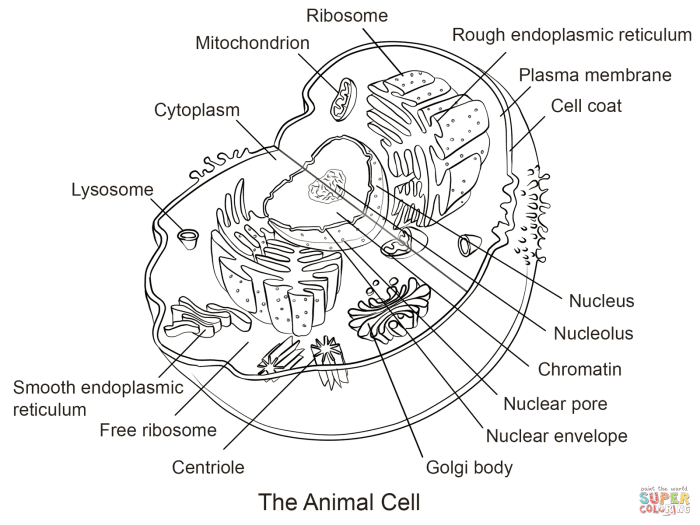Target Audience Analysis

An animal biology coloring page is designed to engage young learners with the fascinating world of animals and their biological characteristics. Understanding the target audience is crucial for maximizing its educational impact and ensuring its appeal. The design, content, and complexity of the coloring page should be tailored to the specific needs and capabilities of the intended users.The primary target audience for an animal biology coloring page is children, specifically within the age range of 4 to 10 years old.
This age range encompasses both preschool and elementary school children, who are at various stages of cognitive and fine motor skill development. This broad range allows for differentiation in complexity – simpler designs for younger children and more detailed, anatomically correct illustrations for older children.
Animal biology coloring pages offer a fun way to learn about animal anatomy. Expanding on this, you might also enjoy the delightful combination of creatures and flora found in animal and flower coloring pages , which provide a broader artistic outlet. Returning to the biological focus, detailed animal biology coloring pages can be particularly beneficial for students studying zoology or related fields.
Educational Level and Interests
The educational level of the target audience spans from pre-reading to early elementary school. Many children in this age group are learning basic animal names, habitats, and simple biological facts. Their interests are typically broad, encompassing animals of all kinds – from common household pets to exotic creatures. Coloring pages can tap into this inherent fascination, making learning enjoyable and engaging.
The illustrations should reflect this broad interest, featuring a variety of animals, potentially grouped by habitat (e.g., jungle, ocean, farm) or biological classification (e.g., mammals, reptiles, birds). This diversity encourages exploration and discovery.
Potential Learning Outcomes
Using an animal biology coloring page offers several potential learning outcomes. Children can develop their knowledge of animal names, appearances, and basic biology. For example, a coloring page featuring a lion could include labels for its mane, paws, and claws, reinforcing vocabulary and anatomical understanding. Furthermore, the activity promotes fine motor skill development through the act of coloring itself.
The precision required to stay within the lines improves hand-eye coordination and dexterity. Beyond these direct benefits, the coloring page can stimulate creativity and imagination. Children can express their artistic skills and personalize their learning experience by choosing their own colors and adding creative details. Finally, the act of coloring can be a calming and relaxing activity, fostering a positive association with learning.
Coloring Page Content Design

This section details the design of the animal biology coloring page, focusing on the selection of animals, their representative biological characteristics, and the overall artistic style. The goal is to create an engaging and educational coloring page that appeals to the target audience while effectively illustrating key biological concepts.The coloring page will feature three animals: a chameleon, a viceroy butterfly, and a polar bear.
These animals were chosen to represent distinct biological characteristics: camouflage, mimicry, and adaptation, respectively. This variety will allow for a more comprehensive learning experience.
Animal Selection and Biological Features
The chosen animals represent key biological concepts that are both visually interesting and easily understandable for children. The inclusion of a legend will further enhance understanding.
| Animal | Feature | Description |
|---|---|---|
| Chameleon | Camouflage | Chameleons are masters of disguise! They can change their skin color to blend in with their surroundings, helping them hide from predators and sneak up on prey. This is a fantastic example of adaptation to their environment. |
| Viceroy Butterfly | Mimicry | The viceroy butterfly looks very similar to the poisonous monarch butterfly. This mimicry protects the viceroy from predators who have learned to avoid the monarch. This is a clever survival strategy. |
| Polar Bear | Adaptation | Polar bears are perfectly adapted to survive in the Arctic. Their thick fur, blubber layer, and large paws help them stay warm and move efficiently in the snow and ice. This showcases how animals evolve to thrive in their unique habitats. |
Artistic Style and Design Elements, Animal biology coloring page
The coloring page will employ a simple yet detailed artistic style. Line thickness will be consistent and relatively thin to allow for easy coloring without overwhelming the image. The level of detail will be moderate, providing enough visual interest without being overly complex. The animals will be depicted in their natural habitats to further emphasize their adaptations.
For example, the chameleon will be shown on a branch amidst leaves, the viceroy butterfly amongst flowers, and the polar bear in a snowy landscape. The overall aesthetic will be bright, cheerful, and inviting, appealing to children while maintaining a scientific accuracy. The background will be simple, allowing the animals to be the focal point, and will incorporate subtle details that complement the animals’ environments, such as leaves, flowers, or snow drifts.
The style will be reminiscent of nature illustrations found in children’s encyclopedias, blending educational value with artistic appeal.
Educational Value Enhancement: Animal Biology Coloring Page

This section delves into the fascinating biology of three animals featured in the coloring page, aiming to enhance understanding and appreciation of their unique adaptations. Each animal profile includes detailed descriptions, fun facts highlighting key biological aspects, and contributes to the overall educational value of the coloring activity.
Giant Panda Biology
Giant pandas (Ailuropoda melanoleuca*) are instantly recognizable for their black and white fur and their specialized diet. Their most striking adaptation is their digestive system, uniquely designed to process bamboo, their primary food source. Unlike other bears, pandas possess a pseudo-thumb, an enlarged wrist bone that acts like a thumb, allowing them to effectively grasp and manipulate bamboo stalks.
This adaptation is crucial for their survival in bamboo forests.
Three fun facts about giant pandas:
- Giant pandas spend up to 14 hours a day eating bamboo.
- Their pseudo-thumb is a remarkable example of convergent evolution, meaning it evolved independently from the thumbs of primates.
- Despite being classified as carnivores, their digestive system is adapted to process a predominantly plant-based diet, showcasing remarkable biological flexibility.
Emperor Penguin Biology
Emperor penguins (*Aptenodytes forsteri*) are the largest penguin species and exhibit extraordinary adaptations for survival in the harsh Antarctic environment. Their counter-current heat exchange system in their flippers and legs minimizes heat loss in freezing waters. Their dense plumage and thick layer of blubber provide excellent insulation against the extreme cold. Furthermore, their streamlined bodies are perfectly suited for efficient swimming and diving.
Three fun facts about emperor penguins:
- Emperor penguins can dive to depths exceeding 500 meters in search of food.
- They endure months of Antarctic winter, fasting while incubating their eggs.
- Emperor penguin chicks huddle together for warmth, creating a massive group that helps them survive the harsh conditions.
African Elephant Biology
African elephants (*Loxodonta africana*) are the largest land mammals on Earth and possess several remarkable biological adaptations. Their large ears, besides hearing, serve as radiators, dissipating heat through a vast network of blood vessels. Their tusks, modified incisors, are used for digging, defense, and stripping bark from trees. Their trunk, a highly versatile prehensile organ, is used for breathing, drinking, eating, and manipulating objects with incredible dexterity.
Three fun facts about African elephants:
- African elephants communicate using infrasound, low-frequency sounds that travel long distances.
- Their tusks continue to grow throughout their lives.
- Elephants possess excellent memories and complex social structures, demonstrating high levels of intelligence.
Coloring Page Quiz
This short quiz tests comprehension of the coloring page content:
Instructions: Answer the following questions based on your knowledge of the animals from the coloring page.
- What unique adaptation allows giant pandas to effectively eat bamboo?
- Name one adaptation that helps emperor penguins survive the Antarctic winter.
- What is the primary function of an African elephant’s trunk?
Page Layout and Design Considerations
Effective page layout is crucial for a successful animal biology coloring page. It needs to be visually engaging to capture children’s attention while maintaining clarity and readability to support learning. A well-designed layout facilitates a positive coloring experience and reinforces the educational content.The optimal layout balances visual elements and text to create a harmonious whole. Margins should be generous, allowing ample white space around the illustrations and text.
Sufficient spacing between different elements—animals, text boxes, and any other design elements—prevents visual clutter and enhances readability. Text should be clearly legible, using an age-appropriate font size and style, ideally placed near the relevant image or section.
Layout Options and Their Comparative Analysis
Several layout options exist for an animal biology coloring page. A single-animal-per-page approach offers a large coloring area, reducing the risk of accidental color bleeding between illustrations. However, this could result in a higher page count, potentially increasing printing costs. Conversely, a multi-animal-per-page layout maximizes space efficiency, reducing the number of pages. This option might, however, lead to smaller coloring areas, potentially causing frustration if the animals are too detailed or closely spaced.
A grid layout could be considered, organizing multiple animals in a structured manner. This option requires careful consideration of spacing to avoid overcrowding. Finally, a free-form layout offers the greatest design flexibility but demands careful planning to ensure a balanced and appealing composition.
Whitespace Utilization for Improved Design
Whitespace, or the empty space around elements, is a powerful design tool. It enhances readability by creating visual breathing room and preventing the page from feeling overcrowded. Consider using larger margins, wider gutters between columns (if applicable), and strategic spacing around text and illustrations. For instance, a large margin around a detailed animal illustration allows the image to breathe and stand out, while ample space between text boxes prevents text from running together.
Strategic use of whitespace guides the eye, making the coloring page easier to navigate and more aesthetically pleasing. In a multi-animal-per-page design, careful use of whitespace ensures each animal has sufficient space, preventing them from feeling cramped. The judicious use of whitespace is not merely about empty space, but about creating visual hierarchy and guiding the user’s eye through the page.
A well-designed coloring page will utilize whitespace effectively to enhance both visual appeal and functionality.
Key Questions Answered
What age group is this coloring page suitable for?
This coloring page is adaptable to various age groups, from elementary school children to older learners. Younger children can focus on the coloring aspect, while older children can engage with the more complex biological information.
Where can I find the printable version of the coloring page?
A printable version will be provided separately (or a link will be provided upon request).
Can this coloring page be used in a classroom setting?
Absolutely! It’s an excellent resource for supplementing classroom learning on animal biology. The quiz included can be used as an assessment tool.












